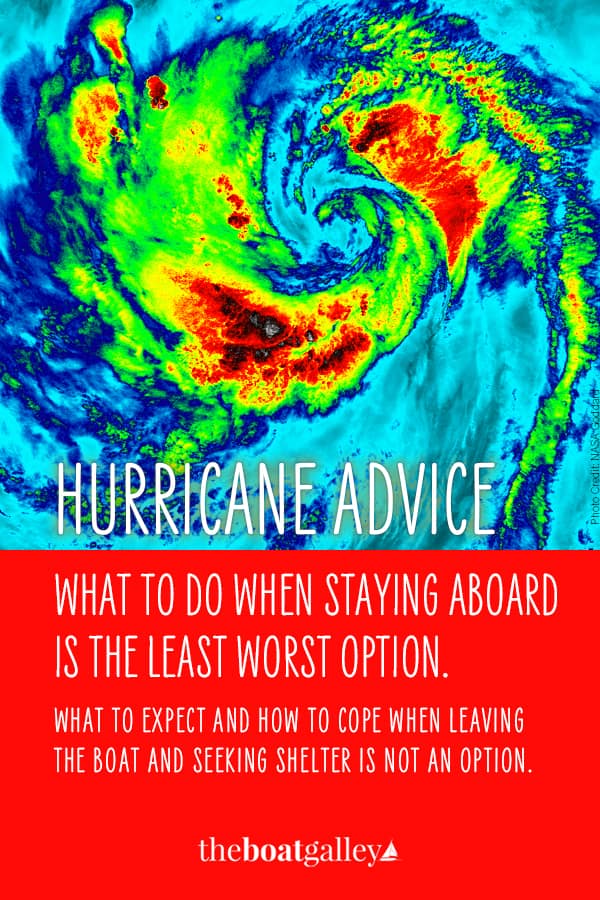
One of the questions that I am often asked about hurricane prep is whether it’s best to stay on the boat or go ashore.
Deciding To Stay On the Boat or Not
My answer is simple:
Seek shelter ashore if at all possible; stay on the boat only if it offers better shelter than anything ashore.
In 2003, we went through Hurricane Marty aboard Que Tal, our Tayana 37. Yes, aboard.
Marty’s eye passed directly overhead as a Category 1 storm. We had anchored in Puerto Escondido, an excellent hurricane hole in the Sea of Cortez. At the time, there were no sturdy buildings ashore (there are concrete buildings there now). The nearest town was 15 miles away, with hitchhiking the only way to get there as the storm closed in. So we stayed on the boat.
We didn’t know if we were taking our lives in our hands or if we’d be able to help Que Tal protect us. Obviously, we survived, as did everyone on the other occupied boats. And in one sense, it wasn’t that scary: we did what we had to, as we had to. But having gone through it and then having seen the aftermath, I would not recommend it at all.
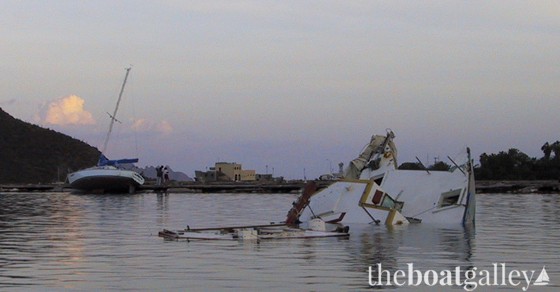
I will never stay on a boat during a hurricane again if there is any reasonable option ashore. But since I’ve done it, I’ll say a few words about staying on the boat.
If You Have to Stay on the Boat During a Hurricane
If there isn’t a viable option ashore and you stay on the boat, the question becomes should you just hunker down below decks or stay on deck. Admittedly, once the winds hit 35 knots or so, there isn’t much you can do. But there are some things you can do to help your boat and yourself.
Perhaps I should first offer a clarification: when I say “stay on deck” I’m not meaning that everyone aboard will be on deck all the time. One person on deck, tethered in the cockpit, on watch.
And keeping watch is probably the most important thing to do. Are you dragging? Is another boat dragging toward you? If you can’t dodge it, you may have to call others on deck to prepare for a collision . . . or a grounding. At the same time, if there are too many unsecured objects flying through the air, everybody may be better off staying below. There are no rules as to what is the best course of action; you have to react to what is actually happening around you.
If you’re going to be on deck, you have to be prepared for it. Hurricane-force winds with torrential rain are ferocious and can result in hypothermia. Our foul weather gear was simply insufficient. Wetsuits kept us much warmer. Wearing our dive masks enabled us to keep our eyes open in the driving rain and it was actually easier to breathe through our snorkels.
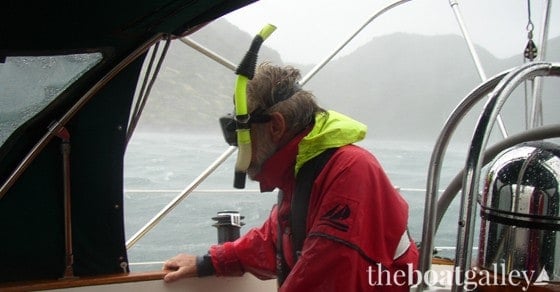
One important thing for anyone who is on a boat during any storm, not just a hurricane: wear shoes all the time. If you have to abandon the boat quickly, or if it should suffer damage, you do not want to be barefoot and you are not going to want to look for shoes. Wear sturdy sandals or sneakers, not flip flops. It’s also a good idea to have some sort of waterproof light — a small flashlight or a glow stick.
How Can You Help Your Boat During a Hurricane
Before the hurricane, we laid out spare chafe gear thinking that we might have to replace it during the storm. HA! It would have been impossible. Put all your chafe gear and backup snubbers on before the storm and don’t expect to be able to go forward on deck during the storm.
During Marty, boaters generally agreed that trying to motor forward on their anchor to relieve the strain actually did the opposite: during lulls, slack would develop in the chain, then gusts would slam the boat back hard on the anchor, threatening to break it out. But if your anchor was dragging, motoring could definitely keep the boat from grounding. Most ended up running the engine in neutral at the height of the storm so that they could put it in gear instantly if needed.
Other boats dragged and didn’t have sufficient engine power to make headway against the storm. But they were able to slow their rearward progress and they could steer sufficiently (yes, while sliding backward) to avoid hitting other boats and hooking someone else’s anchor with theirs. They also could “pick” where they went aground to a certain extent, avoiding rocks in favor of sandy beaches or mangroves.
Is the Hurricane Over?
And one more note about hurricanes, which takes on additional importance if you’re staying aboard: it is very hard to know where the storm center is in relation to you. Your standard weather sources are very likely to be knocked out. Don’t count on the storm going where it “was supposed to.”
Hurricane Marty’s eye was forecast to pass to the east of our location and when the storm suddenly let up, everyone in the harbor thought it was over. Instead, we were in the eye and 30 minutes later we were going through the second eyewall.
Lesson: if it gets too good too fast you are likely in the eye. What do I mean by “too good, too fast?” Well, basically, for what the conditions had been and how long it took to build to those conditions. For example, if the storm built to 70 knots and a total white out over a course of 6 hours, then the wind goes to almost 0 in the space of 5 minutes (our experience in Marty), it’s too big of a change too quickly. If you suspect you’re in the eye, make any repairs or fixes that you need to, but make them quickly and be ready to be back in storm mode at any minute because when the second eyewall hits it will get ugly quickly.
Friends took the following two pictures of Que Tal (the sailboat) about 20 minutes apart — one, just as the eyewall was about to hit (it was a total white out as the eyewall hit) and the second one in the eye (you’ll notice that Que Tal is facing the opposite direction as the wind changed 180° as the eye passed over). We should have realized that the storm was not over, wishful thinking got the better of us.
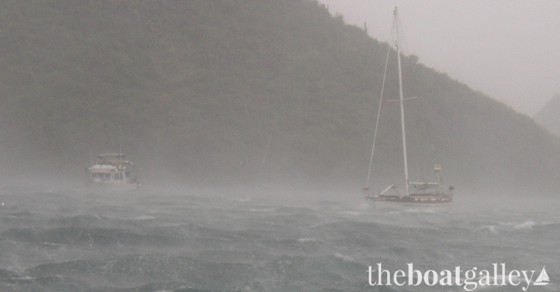
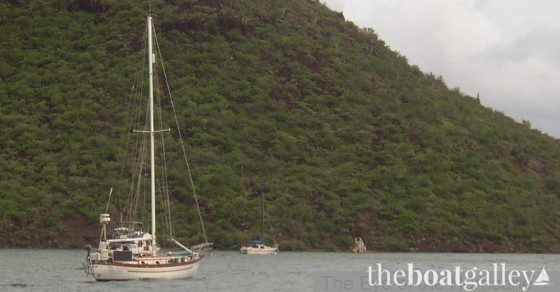
More Hurricane Prep
Learn clear, actionable steps to plan ahead and protect your boat with confidence this hurricane season.
Get Hurricane Ready

Carolyn Shearlock has lived aboard full-time for 17 years, splitting her time between a Tayana 37 monohull and a Gemini 105 catamaran. She’s cruised over 14,000 miles, from Pacific Mexico and Central America to Florida and the Bahamas, gaining firsthand experience with the joys and challenges of life on the water.
Through The Boat Galley, Carolyn has helped thousands of people explore, prepare for, and enjoy life afloat. She shares her expertise as an instructor at Cruisers University, in leading boating publications, and through her bestselling book, The Boat Galley Cookbook. She is passionate about helping others embark on their liveaboard journey—making life on the water simpler, safer, and more enjoyable.
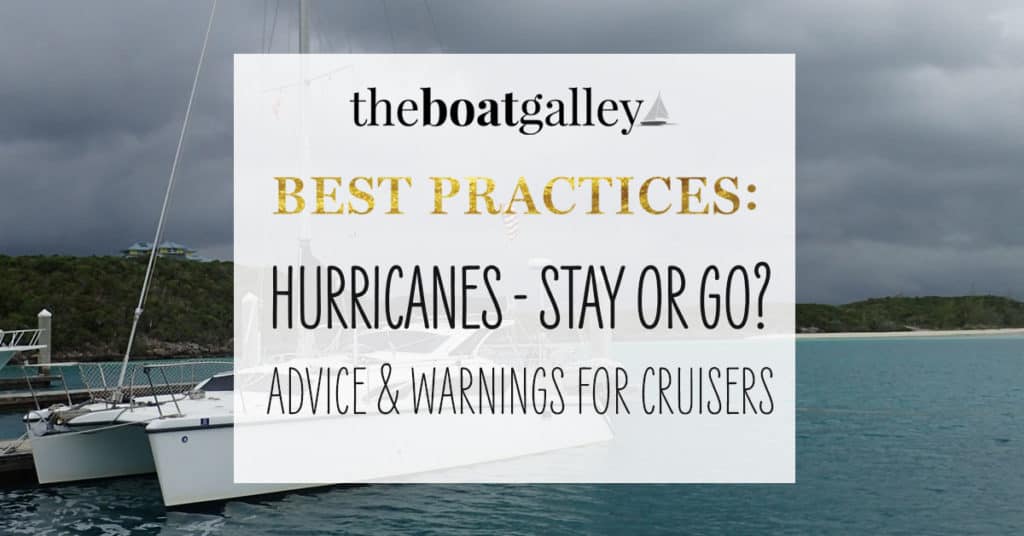



Sherri Stevens says
That’s too scary to think about, stay out of the storms.
Chip Meador says
Once
Steve Barnes says
Scary. Glad you made it through ok. I also would advise against staying aboard if there is any other option. The only time you “might” be safer on the boat is if the surrounding area is very low and storm surge could submerge all of the structure. What type of anchor system did you set up? How many and what type? Did you use a three-point system with the boat centered?
Desiree Golen says
Curious about your anchor set up as well!
Carolyn Shearlock says
We used one anchor — a Bruce 44 — and had our second, a CQR — ready to drop. Had two sets of snubbers (that is, four total) with the second set looser so not taking strain initially but all in place in case the first chafed through. We were in a hurricane hole about 1 mile in diameter with probably 40 other boats, mountains all around except two low places (which still were not totally open). Puerto Escondido in the Sea of Cortez. Oh — and there were NO structures ashore except for an open palm frond palapa.
John Francis says
I really appreciate hearing from someone in a CAT 1r CAT2 … Your CAT1 report gives more realistic information for those in the boating society who might feel that a CAT1 or CAT2, is no big thing, and maybe taken lightly. I’ve been in 45+ knot winds while at dock. My foresail got ballooned out and when 4 people came to my aid, one of the men was being blown downwind on the dock and had to be caught to keep him from going further. This was 45 knots(with gusts)! I cannot imagine functioning on a boat with higher winds.
K. Davie says
Curious what you may have observed (if you had time!) on the barometer as the eye passed over? Might that have been another clue that it “wasn’t over yet”?
And your thoughts on not having set the second anchor before the storm? We’ve debated that – what are your thoughts?
Carolyn Shearlock says
I don’t think anyone looked at barometer . . . we just all went out on deck to look around at where we were, damage, what happened to other boats, etc. And then before we knew it, “halftime” was over.
Glad we did not have second anchor set. Some boats had tried that and found that they had fouled each other right at the beginning of the storm. When you are right on the storm path, it’s impossible to know exactly what the initial wind direction will be. Tiny deviations in the storm path make big changes in wind direction and where you want anchors set.
Frank W Hunt says
I was in Harvey in Rockport, texas. Removed ALL canvas from boat, doubled lines (very high on post), secured ever thing in the cabin Iafer the storm you will find out what can fly across the cabin and went home to Austin, 110 miles away. Could not get back in for four days to see what we had. Broke port bow lines and bent two rail post ninety degree and one pulled a hole in the deck when the boat heaved
over 90 degrees and hit the dock. Winds maxed out there at 170 mph and yes please do not stay. out of about 100 sailboats approx. 80 were totaled. If anyone want to know more you can contact me.